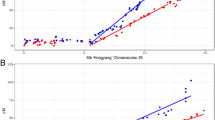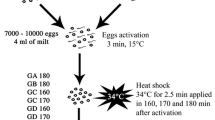Abstract
Genetic sexing technique based on the construction of a balanced lethal strain (BLS) has been proposed for Phthorimaea operculella (Zeller). The isolation of female with T(W;Z) translocation is a fundamental step to develop such a strain. Gamma irradiation was used to induce the requested translocations. The availability of sex-linked morphological marker is required to facilitate the detection of such mutations. Since a visible sex-linked marker has not been found in P. operculella, the main objective of our study was therefore to determine the possibility of using sex heterochromatin body as a marker to identify the required translocated females. The appearance of sex heterochromatin body and the analysis of sex chromosomes in F1 females of irradiated P. operculella females were investigated. The percentage of abnormality in sex heterochromatin body in highly polyploid Malpighian tubule nuclei was positively correlated with the applied dose. Based on the appearance of this body, three mutant lines were isolated: elongated, small and fragmented lines. W chromosome was easily distinguished from Z chromosome when the analysis of pachytene sex chromosome bivalents of P. operculella females was carried out. The aberrations involved in W chromosome directly influenced the appearance of sex heterochromatin body in highly polyploid somatic cells of the isolated mutant lines. The results showed that sex heterochromatin could be used as sex determination and cytogenetic marker in P. operculella.







Similar content being viewed by others
References
Bartlett AC, Del Fosses FE (1991) The pachytene karyotype of the pink bollworm (Lepidoptera: Gelechiidae). Southwest Entomol 16: 223–235
Bedo DC (1984) Karyotypic and chromosome banding studies of the potato tuber moth, Phthorimaea opercula (Zeller) (Lepidoptera, Gelechiidae). Can J Genet Cytol 26:141–145
Carpenter JE, Young JR, Sparks AN, Cromroy HL, Chowdhury MA (1987) Corn earworm (Lepidoptera: Noctuidae): effects of substerilizing doses of radiation and inherited sterility on reproduction. J Econ Entomol 80:483–489
Clarke C, Mittwoch U, Traut W (1977) Linkage and cytogenetic studies in the swallowtail butterflies Papilio polyxenes Fab. and Papilio machaon L. and their hybrids. Proc R Soc B 198: 385– 399
Ennis TJ (1976) Sex chromatin and chromosome numbers in Lepidoptera. Can J Genet Cytol 18:119–130
Fenemore PG (1988) Host-plant location and selection by adult potato tuber moth Phthorimaea operculella (Lepidoptera: Gelechiidae): a review. J Insect Physiol 34:175–177
Haines CP (1977) The potato tuber moth Phthorimaea operculella (Zeller): a bibliography of recent literature and review of its biology and control on potatoes in the field and in store. Rep Trop Prod Inst G112. III, 15
Knipling EF (1966) Further consideration of the theoretical role of perdition in sterile release programs. Bull Entomol Soc Am 12:361–364
Knipling EF (1970) Suppression of pest Lepidoptera by releasing partially sterile males: a theoretical appraisal. BioScience 20:465–470
LaChance LE (1979) Genetic strategies affecting the success and economy of the sterile insect release method. Genetics in relation to insect management. Working Papers. The Rockefeller Foundation Conference, Bellagio, Italy, 1978. The Rockefeller Foundation, New York
LaChance LE (1985) Genetic methods for the control of lepidopteran species: Status and the potential. US Department of Agriculture ARS-28, 40 pp
Makee H, Saour G (1997) Inherited effects in F1 progeny of partially sterile male Phthorimaea operculella (Lep., Gelechiidae). J Econ Entomol 5:1097–1101
Makee H, Saour G (1999) Non-recovery of fertility in partially sterile male Phthorimaea operculella (Lepidoptera: Gelechiidae ). J Econ Entomol 92(3):516–520
Makee H, Saour G (2003) Noninherited sterility in irradiated Phthorimaea operculella females. J Appl Entomol 127: 489–493
Makee H, Saour G (2004) Efficiency of inherited sterility technique against Phthorimaea operculella Zeller (Lepidoptera: Gelechiidae) as affected by irradiation of females. J Veg Crop Prod 10:11–22
Marec F (1991a) Genetic control of pest Lepidoptera: construction of balanced lethal strain in Ephestia kuehniella. Entomol Exp Appl 61:271–283
Marec F (1991b) Genetic control of the pest Lepidoptera: induction of sex-linked recessive lethal mutations in Ephestia kuehniella (Pyralidae). Acta Entomol Bohemoslov 87:445–458
Marec F, Mirchi R (1990) Genetic control of the pest Lepidoptera: gamma-ray induction of translocations between sex chromosomes of Ephestia kuehniella Zeller (Lepidoptera: Pyralidae). J Stored Prod Res 26(2):109–116
Marec F, Traut W (1993) Analysis of structural rearrangements of Lepidoptera chromosomes using the centrifugation spreading technique. In: Howard-Kitto P, Kelleher RF, Ramesh GV (eds) Proceeding of the pests: nuclear and related molecular and genetic techniques, Vienna, 19–23 October, 1992. International Atomic Energy Agency, Vienna, pp 243–250
Marec F, Traut W (1994) Sex chromosome pairing and sex chromatin bodies in W–Z translocation strains of Ephestia kuehniella (Lepidoptera). Genome 37:426–435
Marec F, Kollarova I, Pavelka J (1999) Radiation-induced inherited sterility combined with a genetic sexing system in Ephestia kuehniella (Lepidoptera: Pyralidae). Ann Entomol Soc Am 92(2):250–259
Myers JH, Savoie A, Randen EV (1998) Eradication and pest management. Annu Rev Entomol 43:471–491
Nilsson NO, Lofstedt C, Davring L (1988) Unusual sex chromosome inheritance in six species of small ermine moth (Yponomeuta, Yponomeutidae, Lepidoptera). Hereditas 108:259–265
Ohnuma A (1988) Synthesis of a balanced sex-linked lethal strain in silkworm. Reports of the Silk Science Research Institute, Tokyo, Japan 36:17–25 (in Japanese)
Proverbs MD, Newton JR (1962) Some effects of gamma radiation on the reproduction potential of the codling moth Carpocapsa pomonella L. (Lepidoptera: Olethreutidae). Can Entomol 94:1162–1170
Rananavare HD, Harwalkar MR, Rahalkar GW (1989) Relative efficacy of sterile adults in the control of potato tuberworm Phthorimaea operculella Zeller. J Nucl Agric Biol 18:212–215
Rathjens B (1974) Zur funktion des W-chromatins bei Ephestia kuehniella (Lepidoptera). Isolierung und charakterisierung von W-chromatin-mutanten. Chromosoma 47:21–44
Saour G, Makee H (1997) Radiation induced sterility in male potato tuber moth Phthorimaea operculella Zeller (Lep., Gelechiidae). J Appl Entomol 121:411–415
Saour G, Makee H (1999) Effect of gamma irradiation on sperm utilization in twice-mated female Phthorimaea operculella Zeller (Lepidoptera: Gelechiidae ). J Appl Entomol 123:513–517
Soumalainen E (1969) On the sex chromosome trivalent in some Lepidoptera females. Chromosoma 28:298–308
Strunnikov VA (1975) Sex control in silkworms. Nature 255:111–113
Traut W (1976) Pachytene mapping in the female silkworm, Bombyx mori L. (Lepidoptera). Chromosoma 58:275–284
Traut W, Marec F (1996) Sex chromatin in Lepidoptera. Q Rev Biol 71(2):239–256
Traut W, Mosbacher GC (1968) Geschlechtschromatin bei Lepidoptera. Chromosoma 25:343–356
Traut W, Scholz D (1978) Structure, replication and translocational activity of the sex-specific heterochromatin in a moth. Exp Cell Res 113:85–94
Traut W, Weith A, Traut G (1986) Structural mutants of the W chromosome in Ephestia (Insecta, Lepidoptera). Genetica 70:69–79
Acknowledgment
We thank I. Othman (the Director General of the Atomic Energy Commission of Syria) and N.D. Sharabi (the Head of Department of Agriculture) for their help and support. Also we would like to thank Dr. F. Marec (Ceske Budejovice, Czech Republic) for his advice and the training in his lab. We would like to thank the International Atomic Energy Agency (IAEA) for funding the training fellowship.
Author information
Authors and Affiliations
Corresponding author
Additional information
Communicated by Andreas Vilcinskas
Rights and permissions
About this article
Cite this article
Makee, H., Tafesh, N. Sex chromatin body as a marker of radiation-induced sex chromosome aberrations in the potato tuber moth, Phthorimaea operculella (Lepidoptera: Gelechiidae). J Pest Sci 79, 75–82 (2006). https://doi.org/10.1007/s10340-005-0115-4
Received:
Revised:
Accepted:
Published:
Issue Date:
DOI: https://doi.org/10.1007/s10340-005-0115-4




